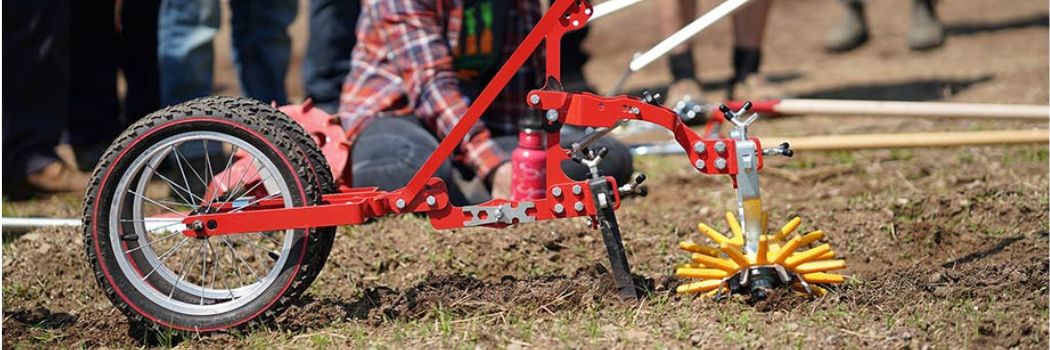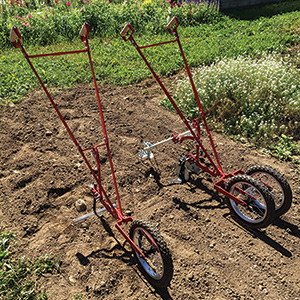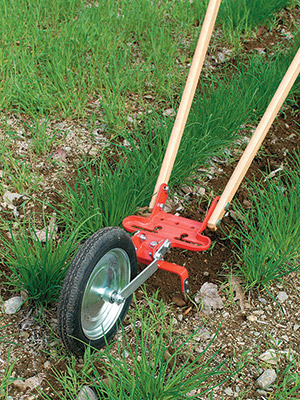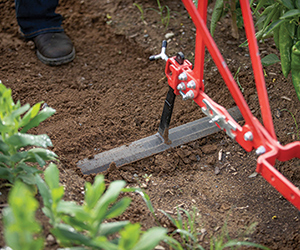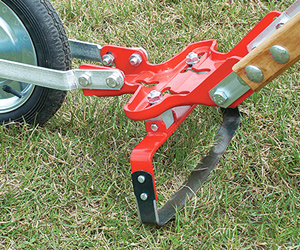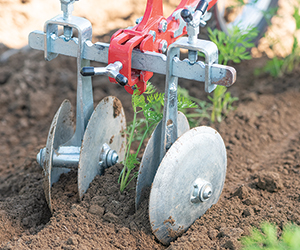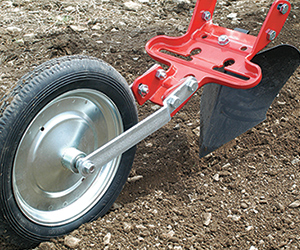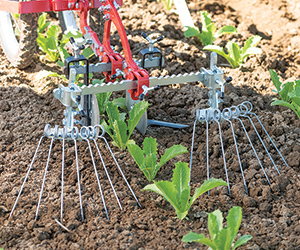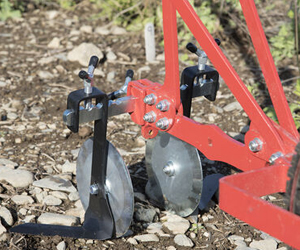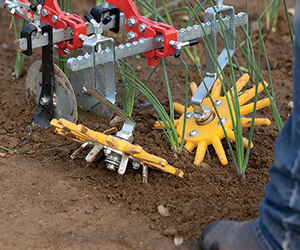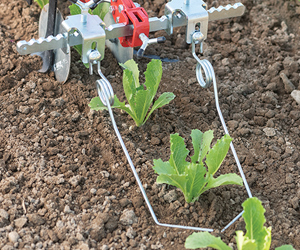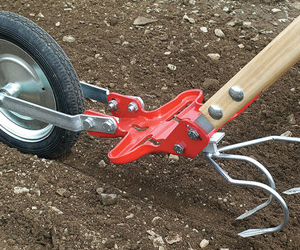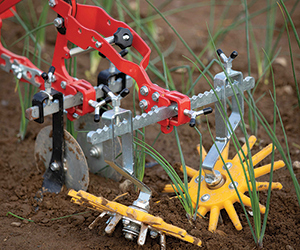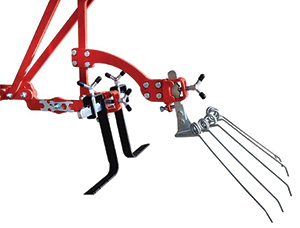- Carrot Growing Guide | Fundamentals of Bed Preparation, Spacing, Weeding & Watering - Part 1
- Collinear Hoes | Tech Sheet (PDF)
- Connecta® Tool System | Assembly & Maintenance | Tech Sheet (PDF)
- Finger Weeders | Instruction Manual (PDF)
- Flame Weeder | Assembly, Backpack Tank Mounting, Usage & Safety Instructions | Tech Sheet (PDF)
- Glaser Wheel Hoe | Double Wheel Conversion Kit | Instruction Manual (PDF)
- Glaser Wheel Hoe | Instruction Manual (PDF)
- Offset Wire Hoe Assembly Instructions | Tech Sheet (PDF)
- Tine-Weeding Rakes | Instruction Sheet (PDF)
- Video: Tine-Weeding Rake Demonstration
- Video: Jack Algiere Demonstrates the Tine-Weeding Rake
- Video: Wire Weeder | Improve Weed Control on the Small Farm
- Video: How to Use & Handle a Silage Tarp to Create a Stale Seed Bed
- Video: Eliot Coleman Demonstrates How to Use Johnny's Collinear Hoe
- Video: Johnny's Flame-Weeder Demonstration
- Video: Using the Glaser Wheel Hoe | Demonstration by Johnny's Selected Seeds
- Video: Johnny's Long-Handled Tools
- Weed Barrier Fabric | Instruction Sheet
- Got Weeds? Targeting Annual & Perennial Weeds
- Weed Management for Sustainable Agriculture | A Two-Pronged Approach
- Long-Handled Weeding & Cultivation Tools | Old & New Favorites
- Wheel Hoe Selection Guide - Find Your Fit
- Wheel Hoe Selection Guide | Tech Sheet (PDF)
- Table of Wheel Hoe Attachments & Compatibilities | Glaser & Terrateck Options from Johnny's
- Johnny's Flame Weeder – 30" | Assembly & Use | Tech Sheet (PDF)
- Connecta® Bed Prep Rake | Connecta Tool System
- Johnny's Flame Weeder Backpack | Instructions for Use | Tech Sheet (PDF)
- Cover Cropping for Field & Garden | Johnny's Educational Webinar Resources
- Terrateck Wheel Hoe Assembly & Instruction Manual | Single and Double Wheel Hoe | in English | (PDF)
- Video: Connecta® Interchangeable Tool System from Johnny's Selected Seeds
- Connecta® Stirrup Hoe | Connecta Tool System
- Johnny's Flame Weeder – 30"
Johnny's Wheel Hoe Selection Guide
About the Wheel Hoe
The wheel hoe first came into widespread use in the U.S. in the late 1800s with the manufacture of the Planet Jr., which provided a low-cost tool for increasing productivity on small-scale farms, where horse power—and later, motorized cultivation—was limited. At the turn of the century and into the first few decades of the 1900s, many market gardeners and other smallholders typically used a single horse to plow the fields in the spring, then cultivated throughout the rest of the growing cycle with wheel hoes.
Down to this day, the wheel hoe is an ideal cultivation tool for the small-scale market gardener, urban gardener, high tunnel or greenhouse grower, homesteader, or avid backyard gardener. As a lightweight, versatile, and maneuverable push-tool, the wheel hoe's ergonomic design provides the user greater leverage than a traditional hand hoe, enabling one to cover ground more quickly.
Among its many advantages, the wheel hoe offers:
- Human-powered use.
- Fossil fuel-free, fume-free cultivation in the field or the protected-culture setting.
- Ergonomic design, allowing the user to remain upright while cultivating.
- Versatility, accommodating an array of attachments and adjustments that make cultivation of various crops and row configurations possible.
- Suitability for no-till and low-till systems.
- Durability and longevity, with few breakable moving parts.
What Is Cultivation?
Cultivation is simply the act of stirring the uppermost layer of the soil to eliminate both small weeds that have emerged and preemergent weeds just below the soil surface. As Eliot Coleman writes in The New Organic Grower:
“Cultivation deals with weeds before they are a problem. Weeding deals with the problem after it has occurred.”
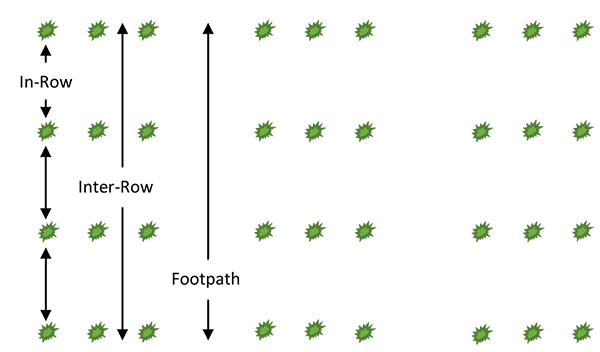
Types of cultivation
The wheel hoe, fitted with the appropriate attachments, can be used to cultivate and weed in three key ways.
- In-row cultivation: Cultivation between crops growing in the same row.
- Inter-row cultivation: Cultivation between rows of crops in the same bed.
- Footpath (pathway) cultivation: Where the goal is to both kill weeds in the footpath and reduce soil compaction.
Choosing your wheel hoe
Johnny's offers two types of wheel hoes to cover all three types of cultivation.
- Single-Wheel Hoes are best for footpath and inter-row cultivation.
- Double-Wheel Hoes are primarily for in-row cultivation, allowing the grower to cultivate on both sides of the crop with a single pass. Note: You must ensure that the crop spacing and height are compatible with the wheel hoe design; see below for more information.
Johnny's Wheel Hoe Models
-
Terrateck Single Wheel Hoe
Country of Origin: France
Uses: Inter-row and footpath cultivation
Weight: 16.5 lb (7.5 kg)Description: The Terrateck Single Wheel Hoe is lightweight and versatile, with a multiplicity of attachment and adjustment options. It offers the option of offsetting the arms, allowing for bed cultivation while walking in the footpath. Attachments can be changed out quickly and easily in the field, without the use of additional tools. You can also "stack" attachments, meaning you can use two attachments at once to simultaneously target weeds in multiple zones, with the use of a Secondary Tool Mount. All attachments are offered separately.
-
Terrateck Double Wheel Hoe
Country of Origin: France
Uses: In-row, inter-row, and footpath cultivation
Weight: 19.8 lb (9 kg)
Description: The double wheel hoe straddles row crops for cultivation on both sides of the plants in one pass. It can also be used for in-row cultivation with the use of attachments such as Finger Weeders. Like the Terrateck Single Wheel Hoe, the Terrateck Double Wheel Hoe is lightweight and can be configured with offset arms, allowing for bed cultivation while walking in the footpath. There are more accessories available for this model than for the single wheel model, and all allow for quick attachment in the field. As with the single wheel hoe, you can combine two attachments to simultaneously target weeds in multiple zones. It is appropriate for use on crops up to 8" in height, with a minimum spacing of 7¼". All attachments are offered separately. -
Glaser Wheel Hoe
Country of Origin: Switzerland (chassis) and USA (ashwood handles)
Uses: In-row, inter-row, and footpath cultivation
Weight: 15.2 lb (6.9 kg) with the 8" oscillating hoe attachment; 16.4 lb (7.4 kg) with the 12" oscillating hoe attachment
Description: Designed after the original Planet Jr. Wheel Hoe of the late 1800s, the Glaser Single Wheel Hoe is lightweight, strong, and highly maneuverable. It has the option to offset the arms, allowing for bed cultivation while walking in the footpath. Several attachments are available. In-row cultivation can be accomplished by hilling soil onto one side of row crops at a time with the hiller attachment. Comes with either a 12"-wide or an 8"-wide center-mounted oscillating stirrup hoe. (An oscillating blade is one that swings back and forth across its central attachment plane, rather than being fixed.)
Choosing Your Wheel Hoe Attachments
The most common attachments for cultivation are the standard cultivating blades such as the oscillating stirrup hoe blades, as well as sweeps and discs for hilling. Johnny's offers these as well as a range of additional attachments designed for different crops and applications for all our wheel hoe models.
See Table of Wheel Hoe Attachments & Compatibilities for options available for each model.
- Collinear Hoe Blades: Designed for shallow cultivation, Eliot Coleman refers to the collinear hoe as a "soil shaver" due to its precise, smooth action just beneath the soil surface. The sharp inner edge of the blade cleanly cuts and lifts thread-stage weeds to the soil surface. This attachment is effective for inter-row and footpath cultivation. Range of widths available for the Terrateck Single Wheel Hoe.
- Stirrup Hoe: This classic cultivation tool is also known as an oscillating hoe, or a "hula-hoe." Sharpened along both the inner and outer edges of its blade, the oscillating stirrup hoe efficiently cuts weeds on forward and reverse strokes as the blade moves back and forth across its attachment plane. Sturdy construction allows the user to cultivate both thread-stage and more mature weeds. Ideal for inter-row and footpath cultivation. Stirrup Hoes are available for Glaser Single and Double Wheel Hoes.
- Bio-Discs: These miniature disc harrows are excellent for in-row weed management and hilling young seedlings like onions, beets, corn, and carrots. Available as an accessory for the Terrateck Double Wheel Hoe, you can remove the inner coulters for a more aggressive hilling.
- Hilling Blades: The hilling blade, also known as a ridger or a furrower, is essentially a V-shaped plow used to create deep furrows for planting or ridges for hilling potatoes, leeks, onions, beans, and peas. It can also be helpful for unearthing root crops for harvest and covering the edges of plastic mulch. Note that Hillers are designed to be used in well-prepared soils. We offer models suitable for the Glaser Single Wheel Hoe and for the Terrateck Wheel Hoes.
- Spring Tine Harrows: This attachment features flexible tines that uproot thread-stage weeds by scratching the soil surface. Most effective on loose, lightly crusted soils without long stem or straw residues, Spring Tine Harrows can be used simultaneously with other cultivation attachments for more complete weed management. Available in fine- or heavy-grade wire, for Terrateck Wheel Hoes only.
- L-Blades and Preci-Discs: These are accessories used for precision cultivation on either side of young crops. Attached to a Terrateck Hoe, L-Blades are most commonly used on crops with an upright habit, and can be adjusted to target weeds right up to the crop base. The Preci-Discs combine 45°-angled blades with coulters — vertical cutting blades — to keep the wheel hoe moving in a straight direction and reduce the disruption of soil crusts that can shift and harm young seedlings.
- Finger Weeders: Attached to a tool bar in pairs that are equally opposed and angled, finger weeders are one of the few tools that target in-row cultivation of thread-stage weeds by fracturing the soil from the root zone upward. The effect is to disrupt weed roots and germinating weed seeds from being in contact with soil moisture. Flexible fingers work safely around row crops with adequate stem strength, such as carrots, corn, brassicas, and lettuce. Finger weeders can be stacked with other attachments for added efficacy. Two models are available, one designed for medium-to-heavy soils and another for soft or sandy soil, for the Terrateck Double Wheel Hoe only.
- Torsion Weeders: Much like Finger Weeders, Torsion Weeders are used for targeting in-row weeds. Fitted with stiff wires that can be set to cultivate right up to the crop stems, Torsion Weeders are especially helpful when cultivating under low-lying crops with a very horizontal growth habit, such as head lettuce.
- Tine Cultivators: These enable the earth to breathe and water to seep in. The 3-Tine Cultivator designed by Eliot Coleman for the Glaser Wheel Hoe features curved tines with flattened tips to quickly and effectively break up crusted and compacted soils. It can be mounted behind the oscillating hoe to loosen soils and cut weeds simultaneously, and is very helpful for weed management as well as for incorporating soil amendments such as compost and fertilizer.
Terrateck Wheel Hoes can accommodate either a 3-Tine Cultivator or a 5-Tine Cultivator attachment. They are both designed to loosen soils that have formed a crust and the removal of late-state weeds. The more robust 5-tine model is wider and cultivates more deeply and aggressively on hardened topsoils to remove late-stage weeds, weed footpaths, or uproot the remains of crops after harvesting.
How to Use a Wheel Hoe Effectively
- For best results, keep your attachment blades sharpened. No sense wasting time with dull blades. By maintaining blade sharpness, your hoe can function at maximal efficiency, which translates to less work for you. We carry a selection of sharpeners and hones for this express purpose.
- Walk at a steady pace while cultivating. Operating your wheel hoe using a push-pull, oscillating motion with your body can help to better break up crusted and heavier soils.
- Find your groove. Where you position the handles of your wheel hoe as you use it depends upon your center of gravity, upper versus lower body strength, and personal preference. Experiment a little with the hoe and how the work feels when using different attachments to determine which angles and forces feel most ergonomically sound for your body.
Additional Features to Consider
Stacking Attachments: Some wheel hoe models are designed to accommodate combined or "stacked" attachments, offering the ability to cultivate a broad area with a single pass. For example, both Finger Weeders and Preci-Discs can be mounted on the Terrateck Double Wheel Hoe (see photo).
Off-Sets: Most of the models we offer provide the option to convert to off-set arms, allowing the user to cultivate crop beds while operating from the footpaths. By staying in the footpath, you can avoid stepping on and re-rooting newly cultivated weeds as well as compacting the soil in the bed. (Note that the Terrateck Offset Handle Assembly is incompatible with use of the Finger Weeders.)
Hardware: Some wheel hoes such as the Terrateck models offer quick Y-bolt style clamps for mounting attachments, making it easy to swap them out in the field by hand without additional tools.
Mounting Accessories: Terrateck wheel hoes models can be fitted with mounting accessories, such as the Secondary Tool Mount, for attaching various types of cultivation tools.
See our Table of Terrateck and Glaser Wheel Hoe Attachments & Compatibilities for more specifics regarding options.
Learn More
We hope this guide helps you determine the best options for your needs from our line of Glaser and Terrateck Wheel Hoes. If you need more information, give us a call or send us an email — we're here to help!
Additional Resources from Johnny's
- Table of Wheel Hoe Attachments & Compatibilities • Chart
- Downloadable, printable version of this article • Tech Sheet (PDF)
- Got Weeds? Targeting Annual & Perennial Weeds • Article
- Flame-weeding Tutorial, by Jean–Martin Fortier, Les Jardins de la Grelinette, St-Armand, Québec • Article
- Johnny's Long-Handled Weeding & Cultivation Tools, Old & New • Article


